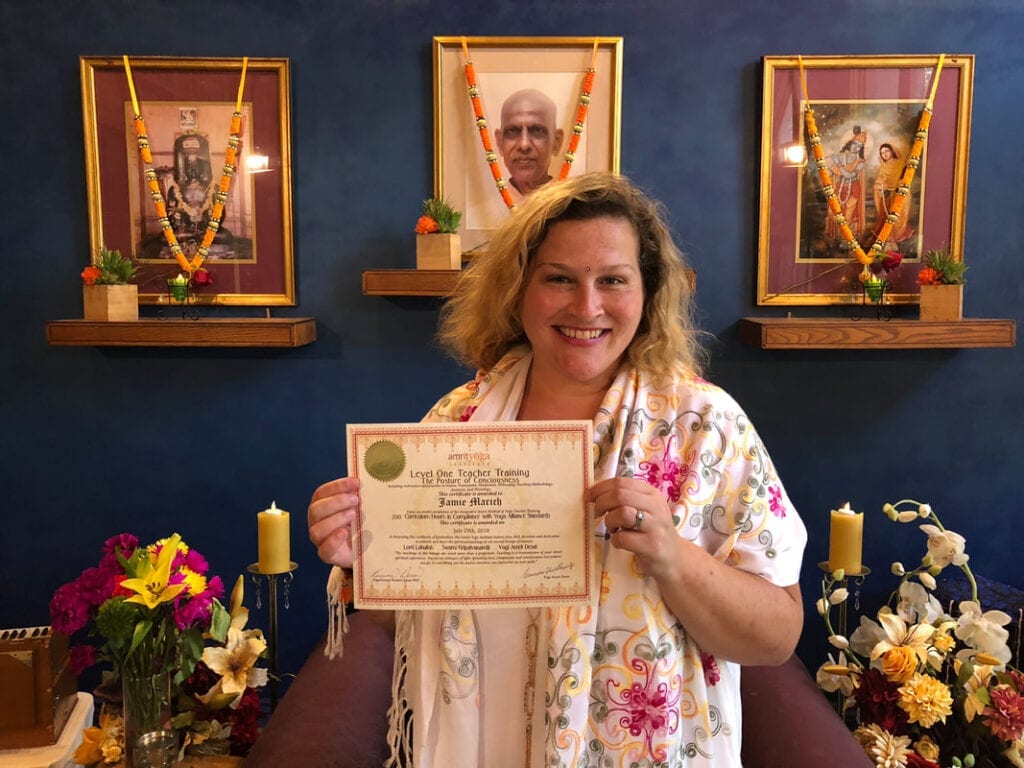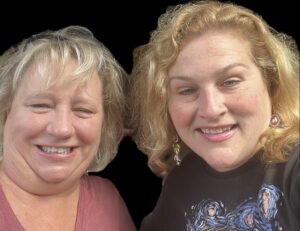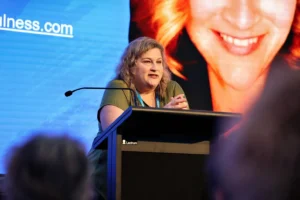My gut squelched as I voiced my protest in the form of this question. For years I yearned to take a full 200-hour yoga teacher training. Because of my hectic schedule with my own training work, arranging one never seemed possible. In the interim, I committed to taking many weekend modules in trauma-informed and recovery yoga, in addition to deepening my own practice. In 2015, I formally discovered the Amrit Yoga system developed by Yogi Amrit Desai, carrier of the Kripalu lineage to the United States. Having been invited to Amrit Yoga Institute (AYI) as a guest teacher in a recovery program, I immediately fell in love with the Integrated Amrit Method and knew that when the time came to take a full teacher training, it would be at AYI. Several amazing things fell into alignment and I was able to take the full 200-hour program in the Summer of 2018, split into two, ten-day modules. When I presented for the first module, my teachers informed me that when returning for the second module, I would be tested on the Amrit method script… and 70% compliance was required to pass!
After my initial question, more protestation flowed: “They can’t box me into a script!,” “I am anything but a scripted person, what the hell did I get myself into?!,” “I haven’t had to do this kind of rote learning since graduate school…what do they expect me to learn from this!?!” Then it dawned on me: the teaching methods employed by the AYI team are not too dissimilar from what I ask my eye movement desensitization and reprocessing (EMDR) trainees to do. In EMDR therapy training, even in a system as mindfulness-infused as my own Institute for Creative Mindfulness curriculum, trainees are asked to stick to a script. In the heart of EMDR therapy, often referred to as the trauma reprocessing stages, the script is very precise as required by the EMDR International Association. While there is room to adapt in some of the other phases, we still ask our trainees to follow a prepared script as we have found this to be the most solid method for educating the majority of our adult trainees who pass through the program. A key difference is that I was being asked to memorize the Amrit Method script and we don’t expect memorization from our trainees, simply that they read from the prescribed script until it becomes second nature to them.
While my challenge felt slightly more difficult, I knew the process would allow me to step into the shoes of what I’ve been asking my trainees to do over the years. A key factor in what helped me to stay optimistic about learning the script is that I as the teacher was allowed to use my own words to teach what is called the second part of the pose in Amrit Yoga. The second part of the pose is the artistry—giving students the time to bask in the stillness of the pose after taking deliberate movement in the first part of the pose (what I had to memorize). A similar process occurs in learning EMDR therapy. There is room for bringing your own clinical judgment and artistry into the practice of EMDR; yet this ought to only come in the context of first assuring a solid technique in one’s set up.
In my several month process of studying on my own and then returning for the second module of intense practice before being tested, I threw every tantrum possible. In addition to the standard issue “I can’t do this” and “I’m incapable,” I found myself beginning to resent the yoga method that I really loved very much and credited with changing my life. I did not feel the same allegiance to Yogi Desai that many of my fellow students and teachers felt and the challenge to “respect his words and his language” didn’t particularly resonate. I did, however, resonate with an explanation given by a teacher that the scripted portion of the pose is designed for us to know how to get people into and out of poses safely. By learning time-tested language for this, the burden of having to grasp for optimal language was removed. As Kalindi, my small group mentor whom I resented many times during the process, taught: “When you don’t have to worry about the language you’re using, something Higher will come through.”
I fought the notion that using someone else’s words—granted words and concepts that I liked very much—would allow my Higher Self to come through in my teaching. By the end of the training process I realized that my dear Kalindi was right. The moment of realization didn’t even come when I took my exam. Although I got through it well and was even able to correct an error that I made with a reasonable degree of elegance, it was in our final class for the whole community that the magic happened. Each of us in our group got to teach a pose and at the relative last minute, I was assigned what I perceived to be one of the more difficult poses in the Amrit sequence: Warrior I. There are a lot of moving parts in the script for Warrior I even though this is a yoga pose I’ve practiced for almost a decade. Getting up in front of my entire cohort and other members of the community, I breathed into it and didn’t experience a shred of nerves. The pose just flowed through me and the experience in my body was one of the most powerful I ever felt as a teacher. And I teach for a living! By time the second part of the pose rolled around and I shared from the organic learning of my own practice, it clicked why Yogi Desai and the entire AYI team put me through this process. I felt a freedom within the structure, and it was glorious!
Throughout the process, and especially in that final class, I realized the power of why we have EMDR trainees learn from a script. For many years I bristled against this teaching methodology. Sure, I learned from the script when I did my own EMDR training in 2005-2006 because I had to. From that initial learning, I found myself resisting the technique of it and improvising a great deal. Much of this adaptation was clinically justified, artistic, and especially needed in serving the most complex clients whose processing work in EMDR therapy will not be very likely to follow a textbook flow. I had a fabulous early consultant who helped me to navigate the finesse around adaptation and modification. After I finished my consultation period, however, I was drawn to other approaches to EMDR therapy that were even more modified and less structured. There was a period of a few years where I taught and even advocated for many of these less structured approaches to EMDR therapy. In becoming an official EMDR trainer, a role that I resisted accepting for years out of fear that I wasn’t “technical” enough, I learned to fall in love with the scripts and the protocols of EMDR in a new way. I discovered that in working with the majority of adult learners that we serve, having the scripted core protocol as the base is the foundation from which a successful EMDR practice in built. As I discuss with my co-author Stephen Dansiger in my latest book EMDR Therapy and Mindfulness for Trauma-Focused Care (2018), the standard protocol is rich with mindful language and concepts, evidence of Dr. Shapiro’s own foundation as a mindfulness practitioner. Granted it took years to work through my initial tantrums about not being a person who exists well in a box to see the beauty in the technical aspects of EMDR. I learned to appreciate that the principles, techniques, and protocols were not the boxes I once feared them to be. Rather, they are tools like paintbrushes, paints, and canvases that allow my clients, with my guidance, to create works of art.
The words of Nirali, my lead teacher throughout the yoga teacher training experience at AYI, sum up what I’ve come to learn as both a yoga teacher and an EMDR therapist/trainer. In one of our closing classes she said, “Learn the rules so that you know how to break them elegantly when you need to. But if you don’t learn the rules you just come off as amateur.” For anyone currently struggling to learn any system that makes you feel boxed into a script, I encourage you to consider this wisdom. If years down the road you are still feeling boxed in and stifled there may be a larger issue to consider here about whether the approach in which you’ve been trained is right for you. My hope is that after an initial period of practice in any scripted or protocol-driven approach you will feel more liberated to be yourself instead of less liberation. This is the art of allowing your Higher Self to shine through in your work, in your life, and in all that you do!




